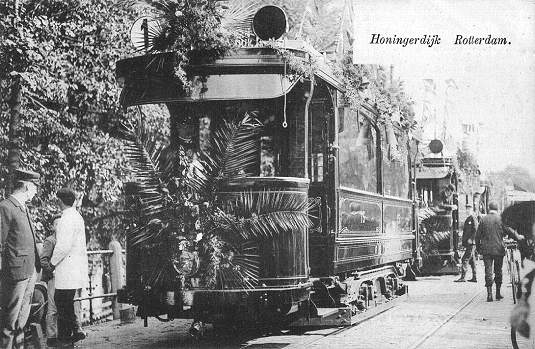

September 18th 2005 marked the centenary of electric trams in Rotterdam, The Netherlands.
In 1878, the Rotterdamsche Tramweg Maatschappij (RTM or Rotterdam Tramway Co.) was formed and horse-drawn trams were operated in the city from 1879 and some steam trams from 1881, but the formation of the Rotterdamsche Electrische Tramweg Maatschappij (RETM., or Rotterdam Electric Tramway Company) on April 7th 1904, using capital raised in Belgium, allowed for the transfer of the horse- and steam-tram networks and set in motion the introduction of electric trams.
Our phototype postcard, one of a set issued for the opening of the new electric tramway, was published by P.F.van der Ende of Rotterdam. It shows car 15 richly decorated at the eastern terminus of the first route to open, appropriately route 1, at Honingerdijk. The procession of about five cars then made its way through the city, via 'Beurs' (the city exchange) to the western terminus at [the] Park, at the end of Westerlaan next to the Nieuwe Maas river. There were terminal loops at both ends from the start. The original Park terminus (not served by trams today) is near the famous Euromast. Amazingly, the eastern half of route 1, from the city centre to Honingerdijk, follows substantially the same line today although the terminus is now called De Esch.
Tram 15 was one of the original batch of 20 cars built by Les Ateliers Métallurgiques of Nijvel (Nivelles) near Brussels, in Belgium. The bodies, with two large windows on each side, had seating for 20 and standing room for 16, although the seating arrangement was slightly different between cars 1-10 and 11-20. They were mounted on 4-wheel, standard gauge trucks fitted with two 20-h.p. motors. Livery was an attractive dark blue with brown side panels. The cars had enclosed fronts fitted in 1908 and in 1912 they were repainted in beige. By 1922, the two large windows had been replaced by six smaller ones on each side. These 20 cars were withdrawn from service by 1931 but two, numbers 1 and 11, survived and still exist in the museum fleet after being restored to original condition.
By 1906, within about 12 months of the system opening, the RETM was already running six electric tram routes and these continued to expand, in both length and number, over many years. Until October 15th 1927, the RETM remained a private company but on that date it was taken over by the city council of Rotterdam and renamed the Rotterdamse Elektrische Tram (RET). Towards the end of the Second World War, lack of electric power caused tram services to cease in 1944. After the war, tram (and bus) services were quickly restored and since then, the tram system has seen a number of new extensions (and a few closures) on both sides of the river. The tramway connection between the north and south parts of the city had been broken many years ago with the opening of the metro in 1968 but now the impressive Erasmus Bridge, carrying tram route 20, has re-connected the two halves of the tram system.
Rotterdam remains a thriving city with an excellent tramway system currently running over nine extensive routes.
![]() Go to Postcard Of The Month Index
Go to Postcard Of The Month Index